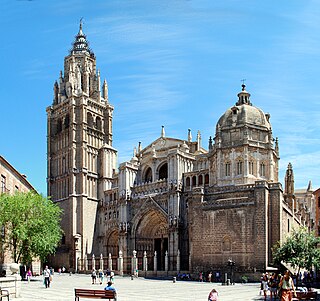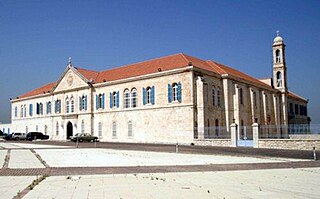Related Research Articles

Sacrosanctum Concilium, the Constitution on the Sacred Liturgy, is one of the constitutions of the Second Vatican Council. It was approved by the assembled bishops by a vote of 2,147 to 4 and promulgated by Pope Paul VI on 4 December 1963. The main aim was to revise the traditional liturgical texts and rituals to reflect more fully fundamental principles, and be more pastorally effective in the changed conditions of the times, clarifying not only the role of ordained ministers but the modalities of appropriate participation of lay faithful in the Catholic Church's liturgy, especially that of the Roman Rite. The title is taken from the opening lines of the document and means "This Sacred Council".

In the practice of Christianity, canonical hours mark the divisions of the day in terms of fixed times of prayer at regular intervals. A book of hours, chiefly a breviary, normally contains a version of, or selection from, such prayers.

The Eastern Catholic Churches or Oriental Catholic Churches, also called the Eastern-Rite Catholic Churches, Eastern Rite Catholicism, or simply the Eastern Churches, are 23 Eastern Christian autonomous particular churches of the Catholic Church, in full communion with the Pope in Rome. Although they are distinct theologically, liturgically, and historically from the Latin Church, they are all in full communion with it and with each other. Eastern Catholics are a distinct minority within the Catholic Church; of the 1.3 billion Catholics in communion with the Pope, approximately 18 million are members of the eastern churches.

Traditionalist Catholicism is a movement that emphasizes beliefs, practices, customs, traditions, liturgical forms, devotions and presentations of teaching associated with the Catholic Church before the Second Vatican Council (1962–1965). Traditionalist Catholics particularly emphasize the Tridentine Mass, the Roman Rite liturgy largely replaced in general use by the post-Second Vatican Council Mass of Paul VI.

The Catholic Church, also known as the Roman Catholic Church, is the largest Christian church, with 1.39 billion baptized Catholics worldwide as of 2022. It is among the world's oldest and largest international institutions, and has played a prominent role in the history and development of Western civilization. The church consists of 24 sui iuris churches, including the Latin Church and 23 Eastern Catholic Churches, which comprise almost 3,500 dioceses and eparchies located around the world. The pope, who is the bishop of Rome, is the chief pastor of the church. The Diocese of Rome, known as the Holy See, is the central governing authority of the church. The administrative body of the Holy See, the Roman Curia, has its principal offices in Vatican City, a small independent city-state and enclave within the Italian capital city of Rome, of which the pope is head of state.

The Mozarabic Rite, officially called the Hispanic Rite, and in the past also called the Visigothic Rite, is a liturgical rite of the Latin Church once used generally in the Iberian Peninsula (Hispania), in what is now Spain and Portugal. While the liturgy is often called 'Mozarabic' after the Christian communities that lived under Muslim rulers in Al-Andalus that preserved its use, the rite itself developed before and during the Visigothic period. After experiencing a period of decline during the Reconquista, when it was superseded by the Roman Rite in the Christian states of Iberia as part of a wider programme of liturgical standardization within the Catholic Church, efforts were taken in the 16th century to revive the rite and ensure its continued presence in the city of Toledo, where it is still celebrated today. It is also celebrated on a more widespread basis throughout Spain and, by special dispensation, in other countries, though only on special occasions.

The Roman Rite is the most common ritual family for performing the ecclesiastical services of the Latin Church, the largest of the sui iuris particular churches that comprise the Catholic Church. The Roman Rite governs rites such as the Roman Mass and the Liturgy of the Hours as well as the manner in which sacraments and blessings are performed.

The Belarusian Greek Catholic Church, or the Belarusian Byzantine Catholic Church, is one of the 23 Eastern Catholic sui iuris particular churches that are in full communion with the Holy See. It is the heir within Belarus to the Union of Brest and the Ruthenian Uniate Church.
The Liturgical Movement was a 19th-century and 20th-century movement of scholarship for the reform of worship. It began in the Catholic Church and spread to many other Christian churches including the Anglican Communion, Lutheran and some other Protestant churches.

Catholic liturgy means the whole complex of official liturgical worship, including all the rites, ceremonies, prayers, and sacraments of the Church, as opposed to private devotions. In this sense the arrangement of all these services in certain set forms is meant. Liturgy encompasses the entire service: prayer, reading and proclamation, singing, gestures, movement and vestments, liturgical colours, symbols and symbolic actions, the administration of sacraments and sacramentals.

Gregory III Laham, B.S., Emeritus Patriarch of Antioch and All the East, of Alexandria and Jerusalem, is the former spiritual leader of the Melkite Greek Catholic Church. He was elected on November 29, 2000, succeeding Patriarch Maximos V Hakim. He retired on May 6, 2017.
Louis Bouyer, CO, was a French Catholic priest and former Lutheran minister who was received into the Catholic Church in 1939. During his religious career he was an influential theological thinker, especially in the fields of history, liturgy and spirituality, and as peritus helped shape the vision of the Second Vatican Council. Along with Joseph Cardinal Ratzinger, Hans Urs von Balthasar, and others, he was a co-founder of the international review Communio. He was chosen by the pope to be part of a team to initiate the International Theological Commission in 1969.
Western Rite Orthodoxy, also called Western Orthodoxy or the Orthodox Western Rite, are congregations within the Eastern Orthodox tradition which perform their liturgy in Western forms.

Robert Francis Taft was an American Jesuit priest, first in the Russian Greek Catholic Church and later an archimandrite of the Ukrainian Greek Catholic Church. An expert in Oriental liturgy, he was a professor at the Pontifical Oriental Institute from 1975 to 2011 and its Vice-rector from 1995 to 2001.
The following outline is provided as an overview of and topical guide to the Catholic Church:

The Metropolitan Andrey Sheptytsky Institute of Eastern Christian Studies (MASI) is an autonomous unit of the Faculty of Theology at the University of St. Michael's College in the University of Toronto, Canada. It specializes in Eastern Christian studies in all its breadth. Special emphasis is placed on the tradition of the Church of Kyiv, although courses, seminars, and conferences also deal with aspects of the theology, spirituality, history, and ecclesial polity of all the Eastern Christian churches — the Eastern Orthodox, Oriental non-Chalcedonian, Assyrian, and Eastern Catholic Churches.
Josef Andreas Jungmann was a prominent Jesuit priest and liturgist. He was an influential advocate of the Liturgical Movement, and is known for his 2-volume history Mass of the Roman Rite, which contributed to informing the reforms to the Mass during and following the Second Vatican Council, as well as his work in the post-Vatican II catechetical movement in the Catholic Church.

The Maronite Church is an Eastern Catholic sui iuris particular church in full communion with the pope and the worldwide Catholic Church, with self-governance under the Code of Canons of the Eastern Churches. The head of the Maronite Church is Patriarch Bechara Boutros al-Rahi, who was elected in March 2011 following the resignation of Patriarch Nasrallah Boutros Sfeir. The seat of the Maronite Patriarchate is in Bkerke, northeast of Beirut, Lebanon. Officially known as the Antiochene Syriac Maronite Church, it is part of Syriac Christianity by liturgy and heritage.
The Eastern Catholic Churches of the Catholic Church utilize liturgies originating in Eastern Christianity, distinguishing them from the majority of Catholic liturgies which are celebrated according to the Latin liturgical rites of the Latin Church. While some of these sui iuris churches use the same liturgical ritual families as other Eastern Catholic churches and Eastern churches not in full communion with Rome, each church retains the right to institute its own canonical norms, liturgical books, and practices for the ritual celebration of the Eucharist, other sacraments, and canonical hours.
Rites, liturgical rites, and ritual families within Christian liturgy refer to the families of liturgies, rituals, prayers, and other practices historically connected to a place, denomination, or group. Rites often interact with one another, such as in liturgical Latinization, and contain subsets known as uses. There are two broad categories which ritual families fall into: Latin or Western rites associated with Western Christianity and Eastern rites associated with Eastern Christianity. The most common rite is the Roman Rite, itself a Latin liturgical rite and further subdivided into uses.
References
- ↑ Biographical information is excerpted from Chirovsky, Andriy, Ed., Following the Star from the East: Essays in Honour of Archimandrite Boniface Luykx (Ottawa, ON: The Metropolitan Andrey Sheptytsky Institute of Eastern Christian Studies, 1992), pp. 9-40.